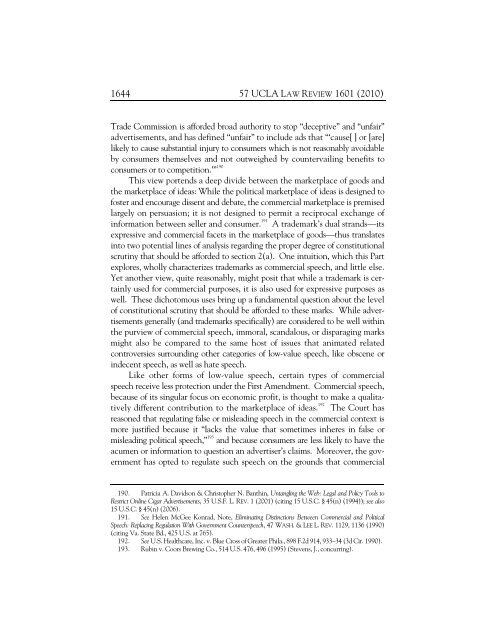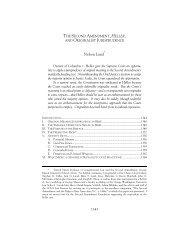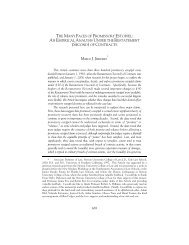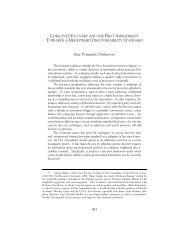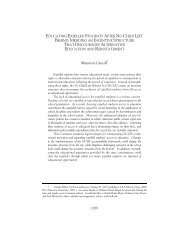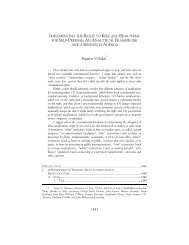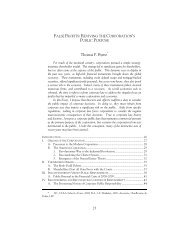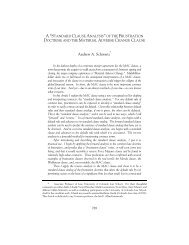Sonia K. Katyal - UCLA Law Review
Sonia K. Katyal - UCLA Law Review
Sonia K. Katyal - UCLA Law Review
You also want an ePaper? Increase the reach of your titles
YUMPU automatically turns print PDFs into web optimized ePapers that Google loves.
1644 57 <strong>UCLA</strong> LAW REVIEW 1601 (2010)<br />
Trade Commission is afforded broad authority to stop “deceptive” and “unfair”<br />
advertisements, and has defined “unfair” to include ads that “‘cause[ ] or [are]<br />
likely to cause substantial injury to consumers which is not reasonably avoidable<br />
by consumers themselves and not outweighed by countervailing benefits to<br />
consumers or to competition.’” 190<br />
This view portends a deep divide between the marketplace of goods and<br />
the marketplace of ideas: While the political marketplace of ideas is designed to<br />
foster and encourage dissent and debate, the commercial marketplace is premised<br />
largely on persuasion; it is not designed to permit a reciprocal exchange of<br />
information between seller and consumer. 191<br />
A trademark’s dual strands—its<br />
expressive and commercial facets in the marketplace of goods—thus translates<br />
into two potential lines of analysis regarding the proper degree of constitutional<br />
scrutiny that should be afforded to section 2(a). One intuition, which this Part<br />
explores, wholly characterizes trademarks as commercial speech, and little else.<br />
Yet another view, quite reasonably, might posit that while a trademark is certainly<br />
used for commercial purposes, it is also used for expressive purposes as<br />
well. These dichotomous uses bring up a fundamental question about the level<br />
of constitutional scrutiny that should be afforded to these marks. While advertisements<br />
generally (and trademarks specifically) are considered to be well within<br />
the purview of commercial speech, immoral, scandalous, or disparaging marks<br />
might also be compared to the same host of issues that animated related<br />
controversies surrounding other categories of low-value speech, like obscene or<br />
indecent speech, as well as hate speech.<br />
Like other forms of low-value speech, certain types of commercial<br />
speech receive less protection under the First Amendment. Commercial speech,<br />
because of its singular focus on economic profit, is thought to make a qualitatively<br />
different contribution to the marketplace of ideas. 192<br />
The Court has<br />
reasoned that regulating false or misleading speech in the commercial context is<br />
more justified because it “lacks the value that sometimes inheres in false or<br />
misleading political speech,” 193 and because consumers are less likely to have the<br />
acumen or information to question an advertiser’s claims. Moreover, the government<br />
has opted to regulate such speech on the grounds that commercial<br />
190. Patricia A. Davidson & Christopher N. Banthin, Untangling the Web: Legal and Policy Tools to<br />
Restrict Online Cigar Advertisements, 35 U.S.F. L. REV. 1 (2001) (citing 15 U.S.C. § 45(n) (1994)); see also<br />
15 U.S.C. § 45(n) (2006).<br />
191. See Helen McGee Konrad, Note, Eliminating Distinctions Between Commercial and Political<br />
Speech: Replacing Regulation With Government Counterspeech, 47 WASH. & LEE L. REV. 1129, 1136 (1990)<br />
(citing Va. State Bd., 425 U.S. at 765).<br />
192. See U.S. Healthcare, Inc. v. Blue Cross of Greater Phila., 898 F.2d 914, 933–34 (3d Cir. 1990).<br />
193. Rubin v. Coors Brewing Co., 514 U.S. 476, 496 (1995) (Stevens, J., concurring).


